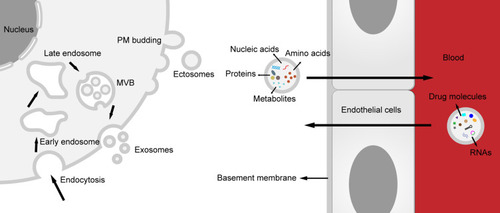Figures & data
Figure 1 Biogenesis of extracellular vesicles (EVs) and transport across the blood–brain barrier (BBB). Two subtypes of EV, exosomes and ectosomes, represent two different biogenesis. Exosomes are derived from endosome pathway, while ectosomes are formed directly through plasma membrane budding. EVs can cross the BBB easily. On the one hand, various components, including nucleic acids, proteins, amino acids and metabolites in the EVs can be transported from the central nervous system (CNS) to peripheral biofluids, on the another, RNAs (including circular RNA, short hairpin RNA and small interfering RNA) and drug molecules (such as catalase, dopamine and Edaravone etc.) can be delivered to the CNS.

Table 1 Biomolecules Expressed Differentially in EVs Were Considered as Biomarker Candidates of Parkinson’s Disease (PD)
Table 2 Applications of EVs in the Therapy of Parkinson’s Disease (PD)
Table 3 Applications of EVs in the Therapy of Stroke
